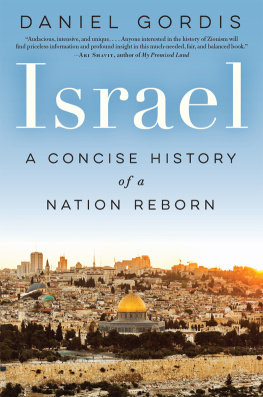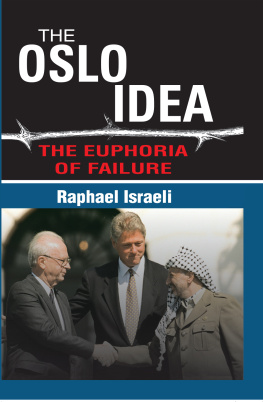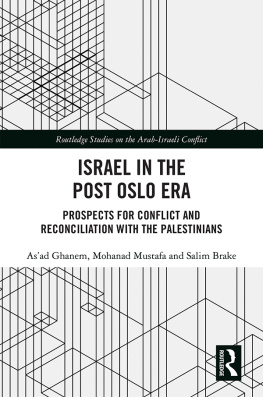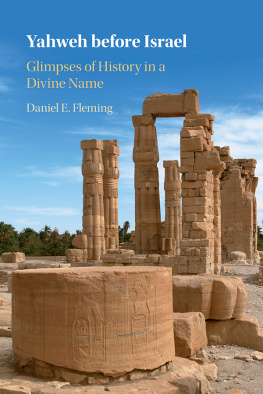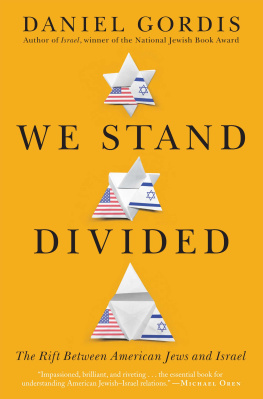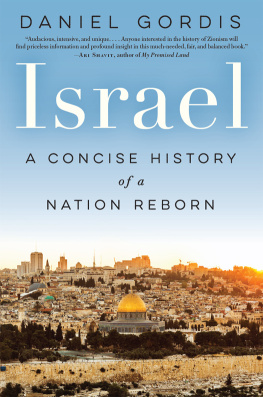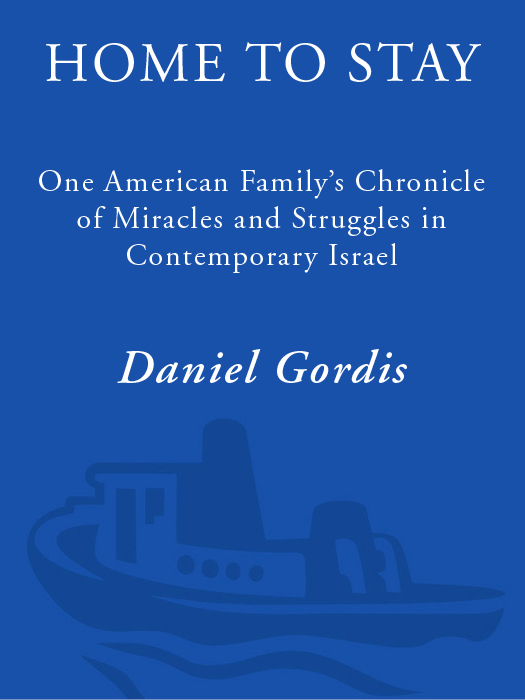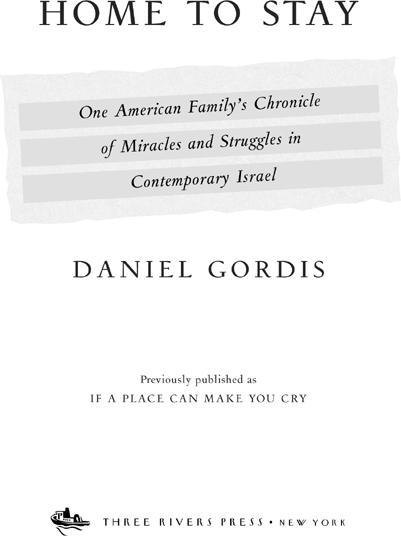Also by Daniel Gordis
God Was Not in the Fire
The Search for a Spiritual Judaism
Does the World Need the Jews?
Rethinking Chosenness and
American Jewish Identity
Becoming a Jewish Parent
How to Explore Spirituality and
Tradition with Your Children
To my brothers and their families
with admiration and with love

Elie and Avra
Tamar, Arielle, and Noah
Yonatan and Robbie
Rakeea and Melila
Je vous ai rapport mes paroles.
Je vous ai parl de la difficult detre Jif,
qui se confond avec la difficult dcrire;
car le judasme et lcriture ne sont quune mme attente,
un mme espoir, une mme usure.
I have already reported to you my words.
I talked to you about the difficulty of being Jewish,
which is the same as the difficulty of writing.
For Judaism and writing are but the same waiting,
the same hope, the same wearing out.
EDMOND JABS (19121991)
Contents
Maps

Because a large measure of the Israeli-Palestinian conflict revolves around the division of land, and because this book makes reference to both places shown in these maps and possible divisions of that land, the following maps are provided as a guide to the reader.
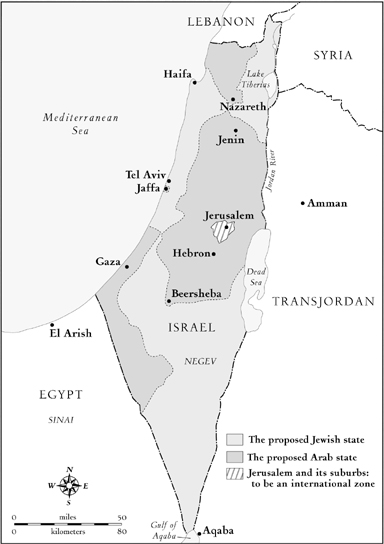
The U.N. Partition Plan1947
This is the division of land proposed by the United Nations, which the Jewish authorities accepted but the Arab authorities rejected. Following this proposed division, the Arab forces attacked the Jewish pre-State entity. At the end of the war, Israel was victorious, resulting in a division of land that is shown on the next page.

The Armistice Agreement1949
These are the borders of Israel at the conclusion of the War of Independence. They remained Israels borders (with a brief exception during the 1956 Sinai Campaign) until 1967, when Israel defeated Egypt, Jordan, and Syria and expanded to the borders shown on the following page.
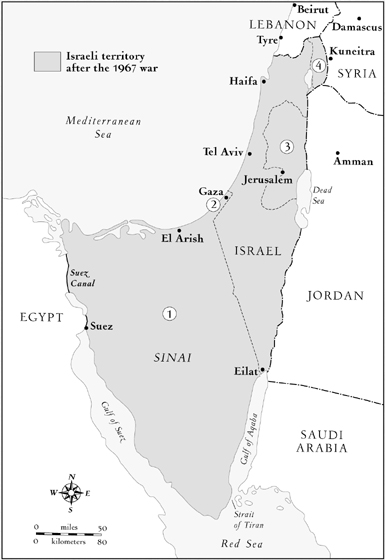
The Cease-Fire Lines1967
These are the cease-fire linesessentially Israels new bordersafter the conclusion of the 1967 Six Day War. Israel captured four major areas: (1) the Sinai desert and (2) the Gaza Strip from Egypt, (3) the West Bank of the Jordan River from Jordan, and (4) the Golan Heights from Syria.

The Oslo Agreement1993
This map shows the portions of the West Bank and Gaza that were returned to the Palestinians after the Oslo Accords. Most of the Gaza Strip was returned, though some Israeli settlements remained, and several key cities in the West Bank (Hebron, Bethlehem, Jericho, Ramallah, Nablus, and Jenin) were also transferred to complete Palestinian control. In other areas, Israel maintained security control while giving the Palestinian Authority jurisdiction over civil matters. The remainder stayed in Israeli hands pending a final settlement.
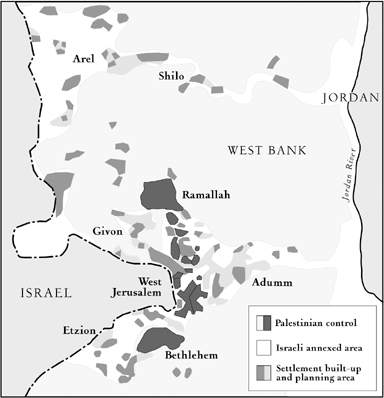
Camp David ProposalsUnofficial Map
A map of a portion of the West Bank as it would be divided between Palestine and Israel under the Israeli Camp David 2 proposals. The map was prepared by Palestinian sources. The significance of the different shadings in areas under Palestinian control is not explained.
Note that Israel is claimed to have retained two broad strips of land, dividing the new Palestine into three noncontiguous areas, something that the Palestinians felt they could not accept. Shortly after negotiations over these maps stalled (among many other critical issues, such as Jerusalem and the right of Palestinian refugees to return to Israel), the Al Aksa Intifada erupted.
Prologue
SEPTEMBER 11, 2001
JERUSALEM, ISRAEL
I ts been two hours since the World Trade Center disaster. I was at my office with Talia, our fifteen-year-old daughter, when a colleague called to ask if Id heard the news. I hadntIm sick of the news. I try to log on to some decent web site, but theres no way to get in. Theyre jammed. I pack up my briefcase and we run home.
Were glued to the TV. Talia and Avi, our twelve-year-old son, are silent, taking in the images that are beyond horrible. Micha, our eight-year-old son, eventually wanders in, and we explain whats happened. To our surprise, he watches for a few moments and then bursts into tears. My wife and I follow him into the living room and sit on the couch with him. He says hes crying because when he was in New York two weeks ago, he wanted to go to the top of the World Trade Center, but we said we didnt have time. Now, he says, hell never get to go.
But we know its not really that. This is the New York City from which he has just come, the place where he was safe from all this. Central Park. Ice skating in Chelsea Piers. Now he knowstheres really no escape. Hes only eight years old, and he has nowhere to run to.
Is Uncle Elie OK? Avi wonders. Weve been trying to call the States nonstop, but theres no getting through. We try e-mail, but have yet to get answers. We assure him that Uncle Elie, my brother, is fine. But how can you be sure he didnt go down there for a meeting? he asks. We cant of course, but theres no way to reach him. Avi goes to sleep on the verge of tears.
Mostly were watching CNN. But we occasionally take a look at Israeli TV, which in addition to the news from New York is showing celebrations in the West Bank. In Nablus, Palestinians are giving out candies in celebration, and gunmen are firing assault rifles into the air to applaud the deaths. In the refugee camp of Balata, and in the Palestinian cities of Tul Karm and Bethlehem, similar celebrations.
It feels as though were surrounded by evil, everywhere. Michas righttheres no escape, and it seems almost impossible to sustain the optimism that everything will one day be OK. Were just back from our summer vacation, and already I desperately need a break. I realize that Im ready for the holidays, for the beginning of a new year. Of course this past Rosh Ha-Shannah was the beginning of all the horror, so its hard to know how optimistic to be. But still, as I look out the window at the beauty of Jerusalem, even in the dark of night, a city thats survived attack and siege for thousands of years, despite everything, hope still seems to win out over despair. Maybe, just maybe, next year will be better.


